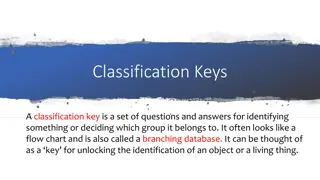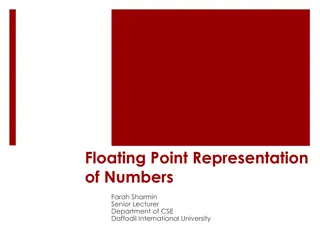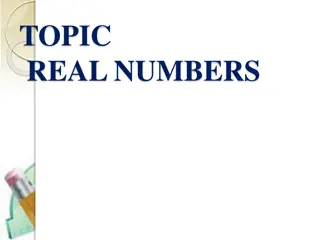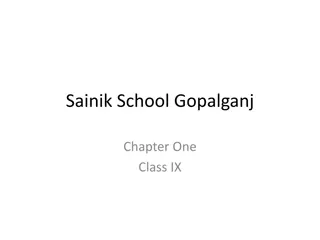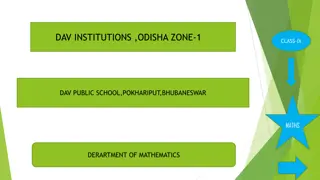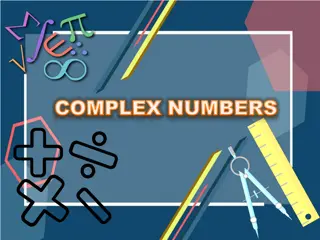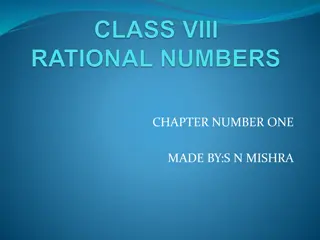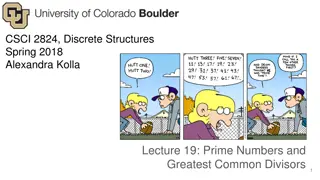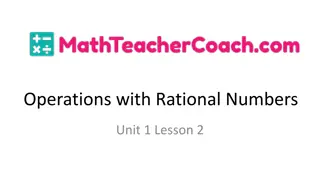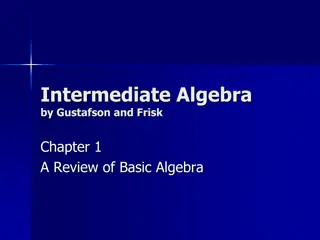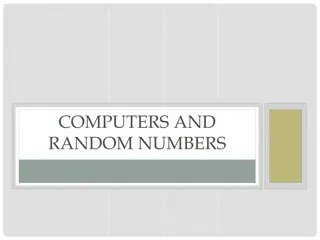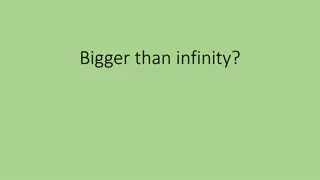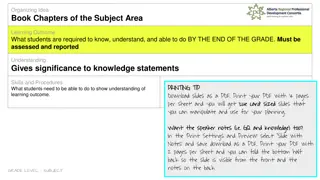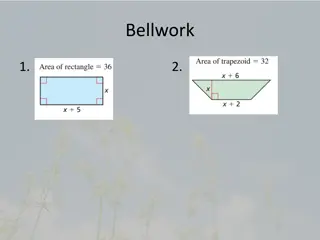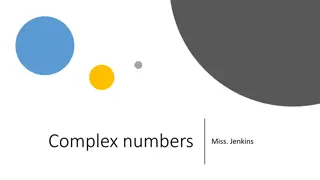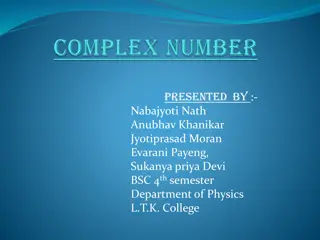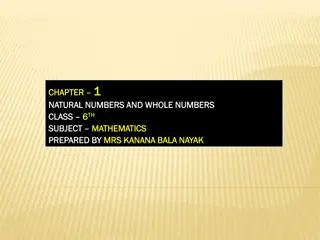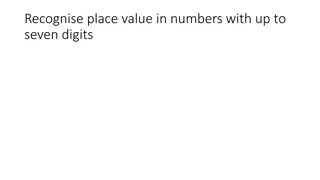Real Numbers: Classification, Operations, and Examples
Real numbers encompass a wide range of mathematical entities, including natural numbers, whole numbers, integers, fractions, rational numbers, and irrational numbers. This chapter delves into the classification of real numbers, Euclid's Division Lemma and Algorithm, finding HCF and LCM using these methods, expressing numbers algebraically, word problems involving HCF and LCM, the Fundamental Theorem of Arithmetic, and more. Discover the essence of real numbers through various topics and examples explored in this chapter.
Download Presentation

Please find below an Image/Link to download the presentation.
The content on the website is provided AS IS for your information and personal use only. It may not be sold, licensed, or shared on other websites without obtaining consent from the author.If you encounter any issues during the download, it is possible that the publisher has removed the file from their server.
You are allowed to download the files provided on this website for personal or commercial use, subject to the condition that they are used lawfully. All files are the property of their respective owners.
The content on the website is provided AS IS for your information and personal use only. It may not be sold, licensed, or shared on other websites without obtaining consent from the author.
E N D
Presentation Transcript
D.A.V PUBLIC SCHOOL , BERHAMPUR REAL NUMBERS CLASS X (MATHEMATICS) CHAPTER -1
SUB TOPICS SUB TOPICS What is Real number ? Classification of Real numbers. Euclid s Division Lemma. Euclid s Division Algorithm. Finding HCF and LCM of numbers by using division lemma and algorithm Expressing odd, even, square, cube numbers in the algebric forms. Word problems related to HCF and LCM. Fundamental Theorem Of Arithmetic. Find HCF and LCM of numbers by using Prime Factorisation Method. Irrational numbers and their prove by contradiction method. Revisiting rational numbers.
Real number The collection of all rational and irrational numbers are called real numbers Therefore all natural, whole, integers, fractions, rational and irrational numbers are called REAL NUMBERS. The counting numbers 1,2,3 .etc are called Natural Numbers. All counting numbers together with 0 forms the collection of Whole Numbers All counting numbers, the negative of counting numbers and 0 form the collection of Integers. Any number that can be expressed in the form p/q, where p and q are integers and q is not equal to 0, is called a Rational Number. Any number c that cannot be expressed in the form of p/q, is called an Irrational Number.
Euclids Division Lemma. Let a and b be the two positive integers, there exists a unique pair of numbers q and r such that a = bq +r, 0 r < b Euclid s Division Algorithm. These are the logical steps implemented to find the HCF of any two numbers.
QUESTION -1 Use Euclid s division algorithm to find the HCF of 10224 and 9648. We do apply Euclid s division lemma to 10224 and 9648 repeatedly till the remainder becomes 0. 10224 = 9648 x1 +576 9648 =576 x16 +432 576 = 432 x1 +144 432 = 144 x3 + 0 As the last divisor is 144, so the HCF of 10224 and 9648 = 144.
QUESTION -2 Show that any positive odd integers is of the form 4q+1 or 4q+3, where q is some integer. Let a be any positive odd integer and b = 4 Then by Euclid s division lemma, we have a = 4q +r, where 0 r <4 The possible values of a are =4q, 4q+1, 4q+2 or 4q+3 The possible values of a are =4q, 4q+1, 4q+2 or 4q+3 For a = 4q = 2 x 2q, so it is even Therefore 4q is even Even+1 is odd Hence 4q+1 is odd Any two conjugative odds are differ by 2, hence 4q+1 +2 is also odd, so 4q +3 is also odd Hence every positive odd integers is of the form 4q+1 or 4q+3
Question 3 Show that the square of any positive integer is either of the form 3m or 3m+1,for some integer m. Solution: Let a be a positive integer, b =3, q be the quotient and r is the remainder. According to Euclid s division lemma, a = 3q+r, where 0 The possible values of a are 3q,3q+1 or 3q+2 For a =3q a2 = 9q2= 3 x 3q2( if 3q2=m, then a2=3m) for a = 3q+1 a2 = (3q+1)2= 9q2+6q +1 = 3(3q2+2q) +1 or 3m+1 so square of any positive numbers are either of the form 3m or 3m+1
Extra Questions Show that the square of any positive integer is either of the form 4q or 4q +1 for some integer q. Show that cube of any positive integer is of the form 4m, 4m+1,or 4m+3 for some integer q. Show Prove that n2 1 is divisible by 8, if n is an odd positive integer. Show that the square of any positive integer cannot be of the form 5q+2 or 5q+3 for some integer q. Show that the square of any positive integer cannot be of the form 6m+2 or 6m+5 for any integer m. Show that the square of any odd integer is of the form 4m+1, for some integer m.
FUNDAMENTAL THEOREM OF ARITHMETIC Every composite number can be expressed as a product of primes which is unique , apart from the order. HCF X LCM ( OF ANY TWO NOS) = PRODUCT OF THE TWO NUMBERS QUESTION: Find the HCF and LCM of 80, 120 and 90 by using the Fundamental theorem of arithmetic.
SOLUTION Prime factors of 80 = 24x 5 Prime factors of 120 = 23x 3x 5 Prime factors of 90 = 2 x 32x 5 HCF of 80, 120, 90 are = 2 x 5 = 10 LCM of 80, 120, 90 are = 24x 32x 5 =720
QUESTIONS 1. The HCF of two numbers a is 80 and LCM is 90, if one of the no is 120, then find the other no. The other no is (80 x90 ) / 120 =60 2. Prove that 12ncan not end with the digit 0. Solution: Any number do end with the digit zero , iff it has factors of both 2 and 5. But 12 = 2 x2 x3, it contain 2 as a factor but don t carry 5 as a factor , hence according to the above condition 12ndon't end with the digit zero.
Using prime factorisation method, find the H.C.F of the following numbers. . 122,152& 182 225,150,180 . 1.252, 2.53,1.52 131,248 & 360 5400,6590 & 5600 . 0.00025, 0.02250 & 0.22550 K. 2125, 4160, & 12180 250,180 & 240 Find the H.C.F OF 65 AND 117 and express it in the form of 65m +117n If the H.C.F of 210 and 55 is expressed in the form of 210 5 +55y ,find y. If d is the H.C.F of 56 and 72 , find x and y satisfying d = 56x +72y . Also , show that x not unique. Show that any positive odd integer is of the form 4q+1 or 4q+3, where q is some integers. Show that one and only one out of n, n+2 and n+4 is divisible by 3 , where n is any positive integer. Show that odd positive integer which is of the form 6q+1 or 6q+3 or 6q+5 is odd. Prove that the square positive integers is of the form of 4q+ or 4q+1 . Prove that the square positive integers is of the form of 5q, 5q+1 or 5q+4. Show that the square of any odd positive integers is of the form 8q+1 .
Revisiting Irrational Numbers Theorem : Let p be a prime number. If p divides a2then p divides a. PROVE THAT 2 IS AN IRR ATIONAL NUMBER. Let us assume 2 is a rational number. So , 2 = p/q ( where p and q are integers, q not equal to 0 and p and q are co primes) P2= 2q2 2 divides p2 2 divides p Let p = 2k P2= 4k2= 2q2 q2 = 2 k2 2 divides q2 2 divides q So p and q are divisible by 2, hence are not co primes. This is the contradiction, arise due to wrong assumption, hence is an irrational number.
Similar Questions Prove that 3, 5, 7, 2 3, 2+ 3, 3+2 5, 2+ 3 are irrational numbers by using the method of contradiction. Let us prove ( 2+ 3) is an irrational number Let us assume ( 2+ 3) is rational So ( 2+ 3) = p/q ( where p and q are integers, q 0 and p and q are co primes) 2 +3+2 6 = P2/q2 6 = p2 -5q2/2q2 For all integers p and q the above expression is rational So 6 is also rational Th is is a contradiction arise due wrong assumption, hence 2+ 3 is an irrational number.
Revisiting Rational Number Any rational number in the form of p/q gives terminating decimal representation iff q can be expressed either in the form of 2mor 5nor 2mx 5n ifthe denominator is other than the above forms then it gives non terminating repeating decimal repesentation.


